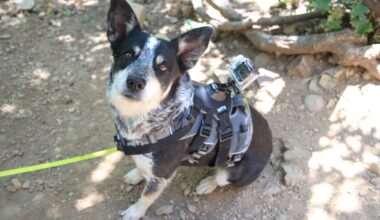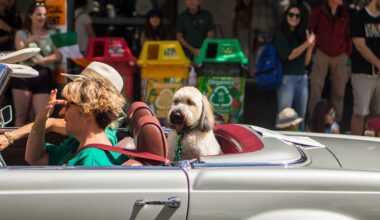Introducing Dogs to Newborns: Safety Precautions
Welcoming a newborn into a family that already has a dog is a beautiful moment filled with joy and excitement. However, it is imperative to prioritize safety as both the baby and the dog require special attention to create a harmonious environment. Careful planning is essential to ensure that their interactions are safe and positive. Begin by preparing your dog for the changes ahead, as dogs can easily sense shifts in their surroundings. Introduce new routines gradually, so your dog becomes accustomed to the different sounds and sights that accompany a baby. It’s wise to teach your dog simple commands like “sit,” “stay,” and “down” to reinforce their behavior. Provide plenty of distraction and stimulation for your dog, engaging them with toys or games during the initial period of adjustment. Reserve specific spaces for both your baby and dog, separating their areas for safety. Use baby gates to restrict access and introduce your dog to baby items well in advance, such as bottles, blankets, and toys. Above all, patience will be your greatest ally during this transitional phase. It is a learning period for both your dog and baby, requiring understanding and care.
Preparing Your Dog
Before bringing your newborn home, ensure that your dog is ready for this life-changing event. Schedule a visit to the veterinarian for a thorough check-up and make sure all vaccinations are up-to-date. This not only protects your dog but also ensures a healthy environment for your baby. Additionally, consider enrolling your dog in obedience classes if they haven’t already received training. Working with a professional trainer can enhance your dog’s behavior around children. Familiarizing your dog with baby sounds, like coos and cries, can help in reducing their anxiety upon hearing them for the first time. Use recordings of baby noises during training sessions so that the dog can adjust comfortably. Also, ensure your dog has a quiet sanctuary space where they can retreat when needing some downtime. Monitor their interactions closely to establish a positive relationship between the dog and baby right from the outset. Reinforce good behavior around the baby with treats and praise, establishing a pattern of positive experiences associated with the new family member. All these steps will make for a smoother transition and allow everyone to be comfortable in the new family dynamic.
Once you bring your newborn home, the first interactions between your baby and dog should be supervised closely. Allow your dog to sniff the baby’s items before they meet the baby, as this can help your dog feel more secure with new smells around. When they do meet, have someone else hold the baby, while you maintain a calm demeanor and gently introduce the two. Encourage your dog with a calm voice while observing their reactions. Never force the interaction; give your dog the option to approach when they feel comfortable. Be vigilant for any signs of jealousy or anxiety from your dog, which may require immediate intervention. Meeting at an appropriate pace allows both your dog and baby to explore the connection naturally. Also, keep your dog leashed initially to ensure control over the situation. Encourage exploration and let your dog see the baby as a new family member, not a threat to their space or attention. It is essential for the bond to form in a relaxed manner, promoting a safe and nurturing development for both the dog and the baby over time.
Establish Boundaries
Establishing boundaries is vital to ensuring safety between your newborn and dog. From the outset, decide where the baby will spend their time, and recognize that the dog’s space should also be respected. Create a clear separation strategy, especially during feeding and naptimes, where both the baby and dog have distinct areas. Baby gates can play an essential role in preventing unsupervised interactions, keeping everyone safe. In addition to physical barriers, it’s vital to ensure your dog learns specific cues. Use commands like “go to your spot,” teaching your dog to settle down while the baby is being cared for. Teaching dogs to respect the baby’s space will foster positive long-term interactions. As your baby grows, they will understandably become more mobile and curious, making it necessary to continue supervision. Instill a routine that allows both the dog and the baby some dedicated quality time with you present, letting them grow to trust each other. Consistency in training will deepen this bond, helping both your baby and dog feel comfortable as they discover their new roles in the family.
Another critical aspect is management during open playtime or when introducing toys. Children are often prone to accidentally pulling tails or ears, which may provoke aggressive behaviors even in affectionate dogs. Teaching your baby gentle habits is essential as they grow. Use dolls or stuffed animals to model these behaviors. Children should learn the importance of respecting a dog’s personal space and how to interact safely with pets. Teach them commands like “gentle” or “soft touch,” reinforcing positive interactions. Focus on providing age-appropriate toys that the dog can enjoy and ensuring that baby toys are kept separate. Whenever the dog is playing with a toy, supervise interaction, preventing babies from grabbing it unexpectedly. As toddlers start gaining mobility, it becomes essential to help them understand boundaries and interactions that are acceptable. This builds confidence within your dog, ensuring they don’t feel threatened or uncomfortable. Consistent reinforcement of behavior through positive experiences will enable a lasting friendship between your dog and child, fostering a sense of companionship and trust. Preparing them for shared experiences will enhance their bonding tremendously.
Health Considerations
Health should always be a priority when introducing your newborn to your dog. To maintain a healthy environment for both your baby and pet, ensure regular veterinary visits for your dog, focusing on vaccinations and parasite control. A healthy dog is less likely to pose threats to your baby. It’s also critical to maintain cleanliness in shared areas to prevent allergies or infections associated with pet hair or dander. Regular grooming and cleaning of the living space will contribute extensively to maintaining a healthy atmosphere. Consider consulting with your pediatrician for further advice on managing pet interactions during the early stages, especially if your baby has shown signs of allergies. If pets aren’t properly maintained, they can introduce unwanted bacteria into the home. Creating a diaper change zone away from the dog can help ensure safety. Understand your dog’s temperament and personify that into your decision-making, recognizing when they might feel overwhelmed. This helps prevent any abrupt reactions. Good hygiene practices and constant vet check-ups should accompany your familial adjustment, focusing on preparing your dog for a life with the newest family member.
Finally, always bear in mind that patience and understanding are key aspects during this transition. This adjustment period may vary per family and can often require more time than initially expected. Being patient with your dog’s behavior ensures they feel secure as they learn to navigate their new relationship. The dog will need time to adjust to the baby’s routine and presence. Show empathy towards your baby’s budding personality as they learn to interact with pets. Patience encourages positive behaviors from both ends; it allows them to communicate and share experiences without fear. Always remember to keep communication open among family members regarding dog behavior, and what’s expected from both the dog and baby. Set regular check-ins to discuss boundaries, management practices, and any concerns arising during this phase. As each family adjusts uniquely, take stock of progress as everyone grows accustomed to their surroundings. An open and adaptable mindset will be invaluable during this exciting and sometimes challenging phase. This thoughtful approach will help cultivate a loving and safe environment for all.


